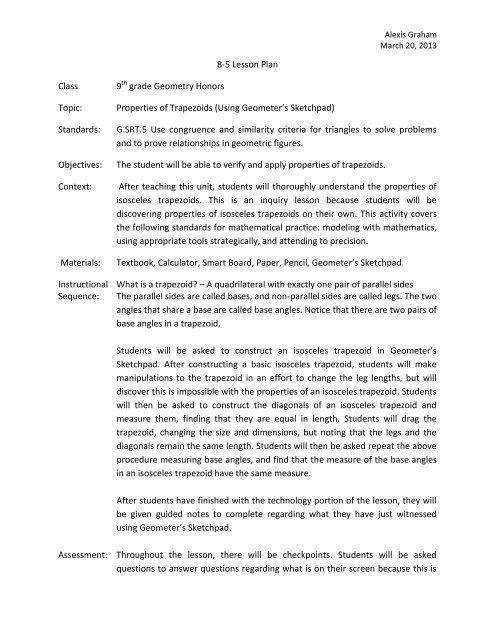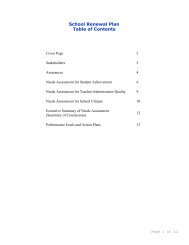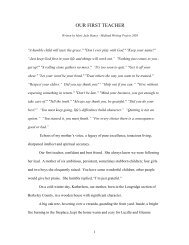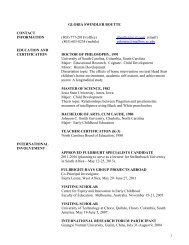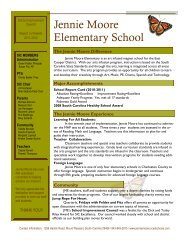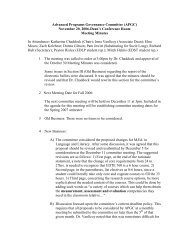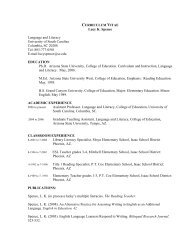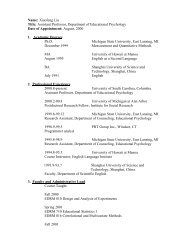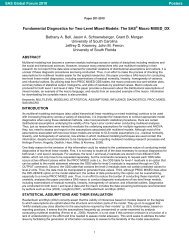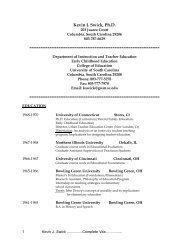8-5 Lesson Plan Class 9th grade Geometry Honors Topic ...
8-5 Lesson Plan Class 9th grade Geometry Honors Topic ...
8-5 Lesson Plan Class 9th grade Geometry Honors Topic ...
Create successful ePaper yourself
Turn your PDF publications into a flip-book with our unique Google optimized e-Paper software.
<strong>Class</strong> 9 th <strong>grade</strong> <strong>Geometry</strong> <strong>Honors</strong><br />
8-5 <strong>Lesson</strong> <strong>Plan</strong><br />
<strong>Topic</strong>: Properties of Trapezoids (Using Geometer’s Sketchpad)<br />
Alexis Graham<br />
March 20, 2013<br />
Standards: G.SRT.5 Use congruence and similarity criteria for triangles to solve problems<br />
and to prove relationships in geometric figures.<br />
Objectives: The student will be able to verify and apply properties of trapezoids.<br />
Context: After teaching this unit, students will thoroughly understand the properties of<br />
isosceles trapezoids. This is an inquiry lesson because students will be<br />
discovering properties of isosceles trapezoids on their own. This activity covers<br />
the following standards for mathematical practice: modeling with mathematics,<br />
using appropriate tools strategically, and attending to precision.<br />
Materials: Textbook, Calculator, Smart Board, Paper, Pencil, Geometer’s Sketchpad<br />
Instructional What is a trapezoid? – A quadrilateral with exactly one pair of parallel sides<br />
Sequence: The parallel sides are called bases, and non-parallel sides are called legs. The two<br />
angles that share a base are called base angles. Notice that there are two pairs of<br />
base angles in a trapezoid.<br />
Students will be asked to construct an isosceles trapezoid in Geometer’s<br />
Sketchpad. After constructing a basic isosceles trapezoid, students will make<br />
manipulations to the trapezoid in an effort to change the leg lengths, but will<br />
discover this is impossible with the properties of an isosceles trapezoid. Students<br />
will then be asked to construct the diagonals of an isosceles trapezoid and<br />
measure them, finding that they are equal in length. Students will drag the<br />
trapezoid, changing the size and dimensions, but noting that the legs and the<br />
diagonals remain the same length. Students will then be asked repeat the above<br />
procedure measuring base angles, and find that the measure of the base angles<br />
in an isosceles trapezoid have the same measure.<br />
After students have finished with the technology portion of the lesson, they will<br />
be given guided notes to complete regarding what they have just witnessed<br />
using Geometer’s Sketchpad.<br />
Assessment: Throughout the lesson, there will be checkpoints. Students will be asked<br />
questions to answer questions regarding what is on their screen because this is
Alexis Graham<br />
March 20, 2013<br />
an individual assignment. After each construction students are also supposed to<br />
check with the teacher, and write a conjecture about their measurements since<br />
notes are only given afterward the technology portion of the lesson. At the<br />
beginning of the next class, students will have an admit slip with applied<br />
questions regarding properties of trapezoids.<br />
References: Bennett, Dan. Exploring <strong>Geometry</strong> with The Geometer's Sketchpad. Emeryville,<br />
CA: Key Curriculum, 2002. Print.


